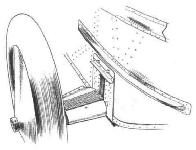
Варианты
- Messerschmitt - BFW M.18 - 1926 - Германия
- Messerschmitt - BFW M.26 - 1930 - Германия
Messerschmitt BFW М.18
Компания "Bayerische Flugzeug-Werke" начала выпускать детали для самолетов в годы Первой мировой войны. После войны, сменив название на "BMW", фирма на долгие годы стала ведущим производителем автомобилей, мотоциклов и моторов для самолетов.
В 1926 году в баварском Аугсбурге была образована новая компания "Bayerische Flugzeugwerke", главным конструктором которой стал дипломированый инженер Вилли Мессершмитт. Под его руководством были спроектированы самые ранние гражданские самолеты фирмы, из которых первым действительно удачным стал BFW M.18. К разработке этого самолета В. Мессершмитт приступил в 1925 году.
Прототип был изготовлен в основном из дерева. Это был высокоплан с консольным крылом, фюзеляжем с плоскими бортами и традиционным хвостовым оперением. Необычными были выполнены основные опоры шасси, основные элементы которых находились внутри фюзеляжа - в результате просвет между поверхностью земли и фюзеляжем получился очень небольшим.
Самолет, управляемый одним летчиком, мог перевозить трех пассажиров. На прототипе стоял звездообразный мотор Siemens-Halske Sh.11 мощностью 80 л. с.
По результатам испытаний прототипа приняли решение о постройке серийных машин, уже цельнометаллических, но частично с полотняной обшивкой. Первые две из них, с моторами Sh.11, обозначались как M.18a, и в 1926 году их передали компании "Nordbayerische Verkehrsflug". Эта компания, а также "Deutsche Verkehrsflug" успешно эксплуатировали 18 самолетов M.18 различных вариантов.
Вариант M.18b (построено 12 машин) отличался от M.18a более мощным мотором Sh.12, экипаж самолета состоял из двух человек, и он мог брать на борт пять пассажиров.
Самолеты варианта M.18c (построено два или три) оснащались моторами Armstrong Siddeley Lynx мощностью 220 л. с. Вариант M.18d (построено 8) представлял собой несколько увеличенный вариант с новым шасси, обеспечившим больший зазор между землей и фюзеляжем. На M.18d ставились различные моторы, включая Wright Whirlwind мощностью 220 л. с., Armstrong Siddeley и Walter Mars мощностью 150 л. с.
ТАКТИКО-ТЕХНИЧЕСКИЕ ХАРАКТЕРИСТИКИ
Messerschmitt/BFW M.18b
Тип: легкий пассажирский самолет
Силовая установка: один звездообразный мотор Siemens-Halske Sh.12 мощностью 112 л. с.
Летные характеристики: крейсерская скорость 140 км/ч на высоте 2000 м; практический потолок 2700 м; дальность 700 км
Масса: пустого 650 кг; максимальная взлетная 1200 кг
Размеры: размах крыла 15,70 м; длина 8,00 м; высота 2,50 м; площадь крыла 24,80 м2
Описание:
- Messerschmitt BFW М.18
- Flight, October 1928
Berlin Aero Show 1928
Фотографии
-
Aeroplane Monthly 1989-10 / J.Stroud - Wings of Peace
A Siemens Sh 11-powered Messerschmitt M 18a.
-
Aeroplane Monthly 1989-10 / J.Stroud - Wings of Peace
Регистрационный номер: D-1266 [2] Messerschmitt M 18b Schweinfurt of Nordbayerische Verkehrsflug with Sh 12 nine-cylinder engine.
-
Мировая Авиация 188
Регистрационный номер: D-1266 [2] Самолет M.18a был одной из первых конструкций Вилли Мессершмитта. Он оснащался мотором Sh.11.
-
Flight 1928-10 / Flight
The B.F.W. M.18 is a small "feeder line" type of monoplane of all-metal construction.
-
Flight 1928-10 / Flight
Big and Little Brother: Two B.F.W. commercial monoplanes, a large 10-seater (the M.20) and a smaller four-seater.
Другие самолёты на фотографии: Messerschmitt BFW M.20 / M.24 - Германия - 1928
-
Aeroplane Monthly 1989-10 / J.Stroud - Wings of Peace
The Siemens Sh 12 installation in the M 18b.
-
Aeroplane Monthly 1989-10 / J.Stroud - Wings of Peace
Регистрационный номер: D-1326, D-1812 Part of Nordbayerische Verkehrsflug’s fleet at Furth aerodrome, Nuremberg, in 1930. Left to right, M 24 D-1767, M 18d D-1812 and M 18b D-1326.
Другие самолёты на фотографии: Messerschmitt BFW M.20 / M.24 - Германия - 1928
-
Мировая Авиация 188
M.18c - вариант M.18, доработанный для проведения аэрофотосъемки.
-
Aeroplane Monthly 1989-10 / J.Stroud - Wings of Peace
This M 18c with 18b-type fuselage, modified undercarriage, and Lynx engine was exported to Switzerland as CH 144.
-
Aeroplane Monthly 1989-10 / J.Stroud - Wings of Peace
An M 18c with M 18d-type fuselage and undercarriage.
-
Aeroplane Monthly 1989-10 / J.Stroud - Wings of Peace
A Messerschmitt M 18d with Wright Whirlwind engine.
-
Мировая Авиация 188
M.18d являлся несколько увеличенным вариантом стандартного M.18 с кабиной, рассчитанной на шесть или семь пассажиров. Построили всего восемь самолетов, в том числе и один с поплавковым шасси.
-
Aeroplane Monthly 1989-10 / J.Stroud - Wings of Peace
Регистрационный номер: D-1405 KEITH WOODCOCK'S painting shows Nordbayerische Verkehrsflug’s Messerschmitt M 18b Gera.
-
Flight 1928-10 / Flight
The B.F.W. M18 has its wheel axle projecting out through the side of the fuselage, the axle fairing serving to form a step, as shown in this sketch.
-
Flight 1928-10 / Flight
Sketch showing tail skid, central elevator crank and handling rail on the B.F.W. M.18.
- Фотографии














